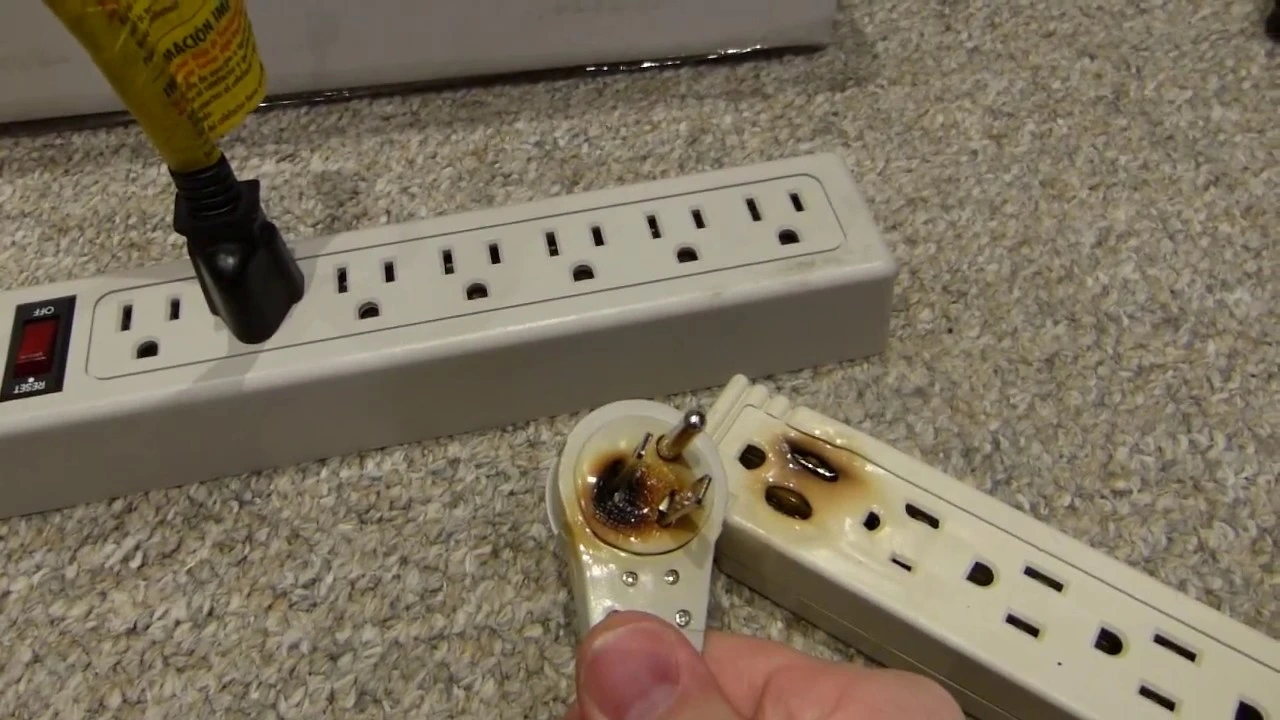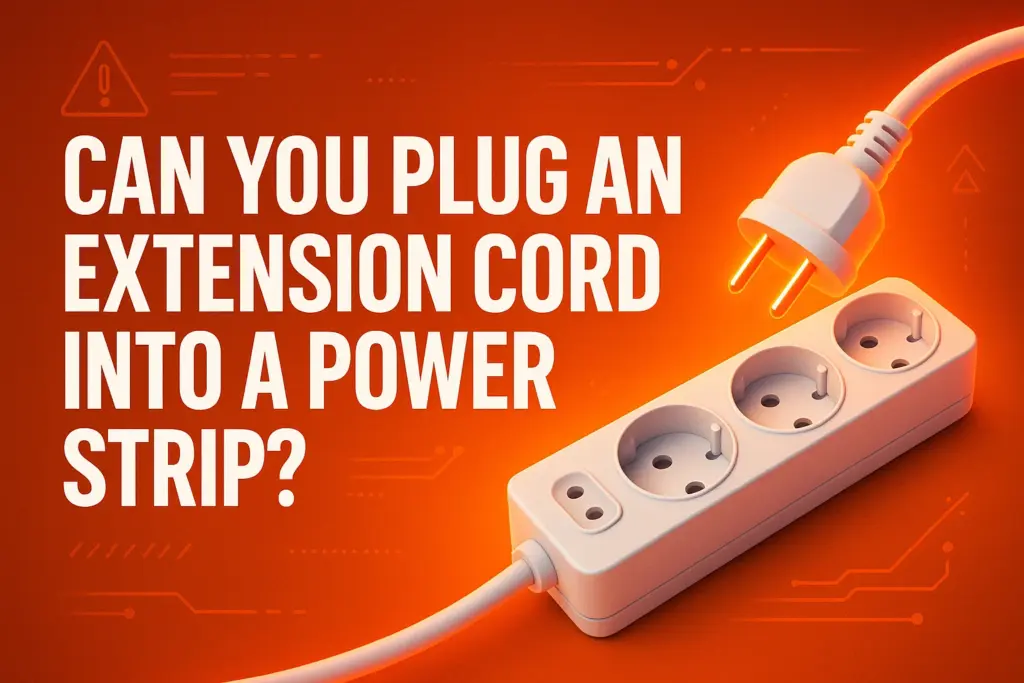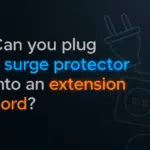If you’ve ever found yourself staring at a tangle of cords trying to power all your devices, you’ve probably wondered about this exact question. Maybe you’re setting up a new home office, decorating for the holidays, or just trying to reach that one outlet that’s frustratingly far from where you need it. Before you make that connection, let me give you the straight answer that could save your home from a potential disaster.
The Direct Answer: Absolutely Not
Let me be crystal clear from the start: you should never plug an extension cord into a power strip. This isn’t just a suggestion or a “best practice” – it’s a serious safety violation that can put your home, your family, and your property at serious risk.
The Electrical Safety Foundation International reports that over 3,300 home fires originate from power strips and extension cords each year, killing 50 people and injuring 270 more. That’s not a statistic I want you to become part of.
Understanding the Basics: What We’re Really Dealing With
What Makes Extension Cords Different
Extension cords are designed for temporary use only – and I mean truly temporary. OSHA regulations specifically state that extension cords can only be used for up to 90 days maximum. After that, they’re considered permanent wiring, which violates safety codes.

Think of extension cords as the electrical equivalent of a band-aid. They’re meant to solve short-term problems, not permanent ones. When you use them beyond their intended purpose, you’re essentially asking for trouble.
Power Strips Have Their Own Limitations
Power strips might look simple, but they’re actually sophisticated devices with specific load capacities. Most residential power strips can handle around 1,875 watts or 15 amperes. That might sound like a lot, but modern devices can eat through that capacity faster than you’d think.
Here’s what a typical power strip can safely handle:
| Device Type | Typical Wattage | Number You Can Safely Plug In |
|---|---|---|
| Laptop Computer | 65W | 25+ units |
| LED Monitor | 30W | 50+ units |
| Desk Lamp | 60W | 30+ units |
| Laser Printer | 400W | 4-5 units |
| Space Heater | 1,500W | Never plug into power strip |
The Science Behind Why This is Dangerous
Heat Generation and Fire Risk
When you connect an extension cord to a power strip, you’re creating what electrical professionals call “daisy-chaining.” This practice dramatically increases electrical resistance, which generates heat.
Think about it this way: electricity flowing through wires is like water flowing through pipes. The longer and more complex the path, the more resistance you create. That resistance converts electrical energy into heat energy, and that heat has to go somewhere.
Overloading: The Silent Killer
MidAmerican Energy emphasizes that overloaded power strips create fire hazards. When you add an extension cord to the mix, you’re not just extending your reach – you’re potentially exceeding the safe capacity of your electrical setup.
Most people don’t realize that electrical devices don’t just use their “running” power. Many devices have startup surges that can temporarily draw much more power than their rated capacity. When you’ve got multiple devices connected through extension cords and power strips, these surges can easily overwhelm your setup.
Legal and Safety Regulations You Need to Know
OSHA Requirements
OSHA (Occupational Safety and Health Administration) has clear regulations about this practice. According to their workplace safety standards, power strips must be “directly connected to a permanently installed branch-circuit receptacle outlet only, not to an extension cord or to another power strip”.

While these regulations technically apply to workplaces, they’re based on fundamental electrical safety principles that apply everywhere. Insurance companies and fire investigators use these same standards when determining liability in home fires.
The 90-Day Rule
Here’s something most people don’t know: extension cords are only approved for temporary use up to 90 days. After that period, OSHA considers them permanent wiring, which must meet entirely different safety standards.
This means that extension cord you’ve had plugged in behind your desk for six months? It’s already violating safety codes, even before you think about plugging a power strip into it.
Real-World Consequences I’ve Seen
Fire Incidents
The Office of Compliance found that daisy-chaining violations were among the most common safety issues during their inspections. These aren’t just theoretical risks – they’re happening in real buildings with real people.
I’ve personally seen the aftermath of electrical fires caused by overloaded power strips. The damage goes far beyond just replacing some electronics. We’re talking about:
- Complete room renovations due to smoke and heat damage
- Loss of irreplaceable personal items
- Potential injury or death to family members
- Insurance complications and claim denials
- Temporary displacement from your home
Insurance and Liability Issues
Here’s something that might surprise you: if your house fire is caused by electrical equipment that wasn’t used according to manufacturer specifications, your insurance company might deny your claim. Using extension cords with power strips violates those specifications.
Safe Alternatives That Actually Work
The Right Way to Get More Outlets
Instead of daisy-chaining, here are solutions that actually work:
For Temporary Needs:
- Use a longer extension cord instead of connecting multiple shorter ones
- Choose heavy-duty extension cords rated for your specific devices
- Rearrange your workspace to be closer to existing outlets
For Permanent Solutions:
- Have a licensed electrician install additional outlets
- Upgrade your electrical panel if you need more capacity
- Install USB outlets for device charging
- Consider smart power strips with individual outlet control
Choosing the Right Equipment
When you do need electrical accessories, invest in quality. Look for:
- UL Listed certification on all devices
- Power strips with built-in circuit breakers
- GFCI protection for areas near water
- Surge protection ratings appropriate for your electronics
What to Do If You’re Currently Doing This
If you’re reading this and realizing you’ve got extension cords plugged into power strips right now, don’t panic – but do take action:
- Unplug everything immediately and assess your actual power needs
- Check all your electrical equipment for signs of overheating or damage
- Rearrange your setup using only direct wall connections for power strips
- Consider calling an electrician if you consistently don’t have enough outlets
The Bottom Line
Look, I get it. Modern life requires a lot of electrical devices, and sometimes it feels like there just aren’t enough outlets to go around. But the solution isn’t to create dangerous daisy-chains that put your home and family at risk.
The National Electrical Code and OSHA didn’t create these regulations to make your life difficult – they created them because people have died from electrical fires caused by exactly this kind of setup.
Your safety is worth more than the convenience of having that extra outlet exactly where you want it. When in doubt, consult with a licensed electrician or invest in proper permanent wiring solutions.
Remember: power strips go directly into wall outlets, extension cords are for temporary use only, and the two should never be connected together. It’s a simple rule that could save your life.
Frequently Asked Questions
1. What if I use a really short extension cord with my power strip?
Length doesn’t matter when it comes to safety. Even a 6-inch extension cord plugged into a power strip creates the same daisy-chaining hazard. The issue isn’t the length – it’s the additional connection point and the fact that you’re exceeding the safe design parameters of both devices. Short extension cords can actually be more dangerous because people assume they’re safer and may overload them more readily.
2. Can I plug a power strip into an extension cord instead?
No, this is equally dangerous and still violates the same safety principles. Whether you plug an extension cord into a power strip or a power strip into an extension cord, you’re still creating an unsafe daisy-chain connection. Both scenarios increase fire risk, violate OSHA regulations, and can void your insurance coverage if they cause damage.
3. Are there any exceptions for outdoor or heavy-duty equipment?
There are no safe exceptions to this rule. Outdoor extension cords and heavy-duty power strips are designed for their specific environments and loads, but connecting them together still creates the same overloading and overheating risks. In fact, outdoor applications can be even more dangerous due to weather exposure and the typically higher power demands of outdoor equipment.
4. What about surge protectors – do they make it safer?
Surge protectors don’t eliminate the fire and overloading risks of daisy-chaining. While they protect against voltage spikes, they can’t prevent the heat buildup and electrical resistance problems caused by connecting extension cords and power strips together. Many surge protectors even have warning labels specifically prohibiting connection to extension cords.
5. How can I tell if my current setup is dangerous?
Look for these warning signs: warm or hot plugs and outlets, flickering lights when you turn on devices, burning smells, scorch marks around outlets, or frequently tripping circuit breakers. If you have extension cords plugged into power strips, or multiple power strips connected together, your setup is dangerous regardless of whether you see these symptoms.
6. What’s the safest way to get more outlets in my home?
The safest permanent solution is hiring a licensed electrician to install additional wall outlets where you need them. For temporary needs, use a single, properly rated extension cord directly from the wall outlet, or move your devices closer to existing outlets. Smart power strips with individual outlet control and USB charging stations can also help manage multiple devices safely.
7. Will my insurance company really deny a claim for this?
Yes, insurance companies can and do deny claims when fires result from electrical equipment being used contrary to manufacturer instructions and safety codes. Since daisy-chaining violates UL listing requirements, OSHA standards, and manufacturer specifications, insurers may consider it negligent use. This could leave you personally liable for tens of thousands of dollars in fire damage that could have been easily prevented.


